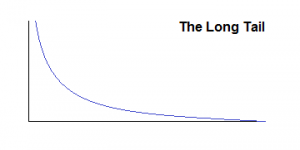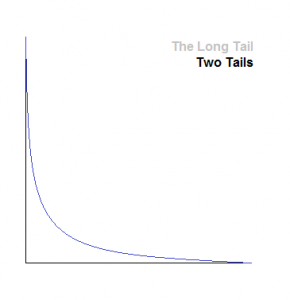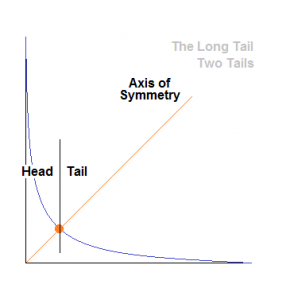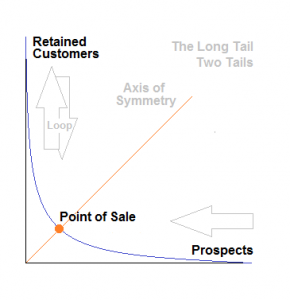A few weeks ago, I proposed a presentation for Seattle Product Camp 11, "Long Tails and Thick Tails for Product Managers." I intended to demonstrate how long tails happen on both sides of the feature-marcom split—a click is a click after all. I also intended to present a knowledge management view of thick tails. It didn't happen. The project blew up, as in became too interesting and just kept on expanding well past the forty-five minutes, later cut to thirty minutes. As it is, just what I talk about in this post would easily eat those minutes.
Since a tweet last week of a link to an SEO presentation on the long tail laid out an interesting application of the long tail, I'll assume you've read the book, the revision, and all the stuff written about the SEO long tail. A few months ago, there was also another tweet mentioning the long tail of search. To that I tweeted a long set of tweets eventually mentioning the thick tail of search, something I called search scarcity in a Product Strategist post of the same name, Search Scarcity.
The Long Tail
So we'll start with Chris Anderson's long tail, a collection of stock keeping units (SKUs) ordered by sales with sales trending to zero to the right. For SEO people, those SKUs are keywords. For myself, they used to be features by frequency of use, but now I'll use minimal marketable functionality and documents by frequency of use. Notice in the latter, I'm talking the stuff product managers focus on, and the stuff product marketing managers focus on.

A typical long tail
In the typical depiction, the left side of the long tail is not shown converging with the vertical axis. The long tail does converge twice. Doing so makes for what mathematicians call a Borel set, which enables us to calculate probabilities.

A long tail has two tails or convergences.
A more mathematical depiction. This depiction shows that the tails are symmetric. The curve represents the function y=1/x. Another function would be skewed in some way.

A long taill with its axis of symmetry, head, and tail.
Being symmetric means that the curve has an axis of symmetry and is symmetric about it. The point where the axis of symmetry intersects the curve was significant for Anderson. It's where he divided the curve into a head and a tail. The head was hits, and the tail was former hits and non hits. For Anderson, this point represented where he put his Pareto split, aka the 80/20 split.
Now, I'm going to do something weird with the two-tailed, long tail. I'm going to use it to represent both the intial sale and the upgrade sales typical of a B2B software company.

Point of Sale on a Long Tail
I made the point where the line and the axis of symmetry intersect the point of sale. The prospect, as in the economic buyer and the stakeholders participating in the purchase, are moved towards the point of sale from the tail of the distribution. After the purchase, the user, in the head of the distribution, moves away from the point of purchase until an upgrade brings them back to the point of sale.
Both tails are comprised of content and functionality. Since permission marketing has and can be used to move training into the pre-sale time frame down the tail of the long tail, we have a mix of content and functionality there. Since a user reads manuals, engages training, and technical support, and since functionality is persuasive, again the head of the long tail consists of a mix of content and functionality. They can end up in a long tail, because both content and functionality are networks of things that have a frequency of use.
Pre- and post-sale Enactment Chains
The movement of the prospect and retained customer towards the point of sale driven by the pre-sale and post-sale enactment chains. In a enactment chain a conversion links one document to another endlessly. The link is sold by conversion text. That conversion text contains an offer and call to action. Each enactment consists of the conversion text and the link. A document can sort prospects out by giving them different self-selecting offers, offers that when taken tell us who the prospect is.
In a B2B situation, the initial sale is made to an economic buyer. It takes six or more exposures/touchpoints/documents before that economic buyer is ready to buy. The economic buyer also involves other stakeholders, each of whom would have their own enactment chains. Sales to retained customers do not require this much effort.
Retaining customers works because sales to retained customers cost between 60 to 90 percent less than sales to initial customers. Capturing this savings in the cost of sale generates an increasing return. Some software companies don't capture their increasing return. At the marcom level, it means marketing to retained customers differently than the way in which prospects are marketed to. Other departments beyond marketing contribute content aimed at increasing a users's expertise that expertise being an exit barrier. It is the user or their immediate department head that makes the decision as to upgrade or not. All they need is an email saying that a new upgrade is available and maybe a few highlights.
That 60 to 90 percent decision lets us build a budget for our marketing to retained customers, aka users.
A Budget on a Long Tail
The distance from the vertical axis and the line dividing the head from the tail can be thought of as 100%, so drawing the cost savings percent vertically will intersect the curve. Where the cost savings percent intersects the curve, a line can be drawn horizontally. That horizontal line would represent the budget.
A Thick Tail
If we rotate the curve, the budget line intersects the curve to give us a thick tail. Nassim Taleb used the thick tailed distribution in his book Black Swan to talk about risk. Yes, budget represents risk.
Thick tails present us with opportunities. We can respond to such opportunities with creativity or not.
It's very likely that we have a budget on tail portion of our long tail as well.
There is much more to say about thick tails. I'll leave that for a future post on my Product Strategist blog.
Now I'll use a thick tail to demonstrate how a content framework can skew the tails of a two-tailed, long tail. We'll start with the basic long tail.
Product Features and Marketing Communications
For much of the content involved in the initial sale and upgrade sales, a ratio exists that informs us as to how much content is needed for each feature.
A One-to-one Feature-Content Ratio
Here I've used a ratio of one to one as a baseline. The axis of symmetry generates that one-to-one ratio. The axis of symmetry provides us with a control. Moving it, will change the ratio.
A Long Tail with a 1-to-5 Ratio
This one-to-five ratio skews the long tail. The head portion of the long tail representing the content is five times longer than the tail portion representing the functionality.
The ratio was driven by a content framework that would create five pieces of content for a given feature. This framework would also have to dictate at what granularity conent would be generated.
At the Seattle Product Camp, questions were raised about how long a lead time is needed for marketing. It depends on whether the sale will be B2B or B2C. It will also depend on content frameworks and granularity decisions. It might also depend on how many new types of content will be generated. Simple answer, no you cannot just throw it over the wall.
Now on to yet another view of the world via a long tail.
To and from General and Specific
This time content is at the bottom. SEO people use key phrases at the convergent end of their tail. The longer the key phrase, the further out the tail will converge, the longer the tail will be. The shorter the key phrase becomes, the closer to the line of symmetry the key phrase will find itself. Eventually, the key phrase is so short that it is just one word, a keyword.
The longer the key phrase, the more specific it is. "The big black Labrador" is obviously more specific that "dog." Length correlates with specificity.
That pretty much accounts for the content side of figure.
As for features, they organize themselves hierarchically. A single control is part of a larger collection of controls. A feature would be that collection. Each control has a frequency of use. Each frequency has, likewise, a frequency of use. Those frequencies organize themselves along a long tail. In our representation, the head of the long tail.
Lets face it, if it exists, it has a frequency.
Features do differ from content. Features are finite and their frequencies play a zero-sum game. If you add a feature, some other features will be contributing frequency to the new features. Content, however, is infinite and their frequencies are not a zero-sum game. Time available to read another document can always be found. "Hey, we would like to close your deal this quarter!" No, that doesn't work. Yes, you can try to expand the amount of time your users spend with your product, but in the B2B deal, if I spent more time with a particular tool, I'd be working overtime.
Expertise moves users to the convergence. Expertise moves the user from general to specific. But, you can't get to those specifics except through the general, and you can't get out of the specifics without going back to the general. Use is an excursion out into boonies of expertise.
Things change. Frequencies shift. Categories converge. Products commoditize. Difference becomes parity. Meaningful differentiation becomes buzzwords.
Commoditization
The lines running parallel to the axis of symmetry are our thresholds of commoditization. Words and features commoditize. Labels on UI components commoditize.
Commoditization happens when consumers refuse to pay more for increase performance along some dimension. Our response is to find another dimension, another vector of differentiation, another technology with a S-curve earlier in the S-curve lifecycle where investment generates large performance improvements. The downside is that this is discontinuous, so it is costly.
Words commoditize as we engage in lexical warfare with our competitors. We turn their differentiation into mud, and turn mud our differentiation. It's raining on the lexical battlefield.
Buzzwords
Perfectly good differentiating words become buzzwords.
Price-based competition and recessions drive us to find marketing and sales approaches that we wouldn't touch in better times. One of those is value-based. In value basing, you organize your offer into chunks from which bundles can be built for a customer's willingness to pay. You don't discount, instead you align value with price on the fly. One of the many things you have to do to do value-based is to classify features by the value they provide. A feature can be a point of difference, a point of contention, or a point of parity. This classification would show up on our current long tail model.
For more info on value based see Anderson's Value Merchant and Weiss' Value-base Fees.
Value Basing on a Two-Tailed, Long Tail
Points of contention force a decision as to whether we will bother with pushing it back into the point of difference status, or let it fall into the points of parity.
By the way, sales hates retention, value-basing, and other tactics beyond demanding sales-marketing alignment. Sales is Markovian; Marketing is Bayesian. Yeah, they'll align in the limiting case. Just warning you if you want to adopt these strategies.
Remember the ratio driving the axis of symmetry? The underlying content framework did that. There are many content frameworks out among the functional units creating content. Five is a low number.
Content Framework
So here is just one example of a content framework. Once the content for those blue boxes is written and published, each of those boxes will accumulate a fequency.
Content Frequencies
Once you have the frequencies, you can order them and connect them into long tails. Here the different long tails are associated with different user roles.
Content Frequencies by Role
Above, another view of content frequencies by role.
Now we can do the the same thing with functionality.
Functionality Frequencies
Use builds the frequencies that comprise a long tail. Notice that we have omitted out content frequencies. We will add them now.
Content and Functionality Frequencies
You can use your content framework to plan the number of content units, but the frequencies should be taken from real data. Your functionality frequencies can be captured on the same server and server logs as your content frequencies. When functionality frequencies change, content frequencies will change.
Now, I'll revisit enactment chains.
An Enactment Chain on Long Tail
Here we put documents and their links, an enactment chain on a long tail.
Functionality in the Enactment Chain
Here we added functionality to the enactment chain.
Enactment Chain for a Single Stakeholder an Radar Diagram
Now we put the stakeholder's long tails on a radar diagram, and then stand the long tails up in a 3-D view.
A Click Chain
Generalizing an earlier view of an enactment chains on a two-tailed long tail consisting of content and functionality we can focus on the similarities and arrive at a click chain. Seeing the world as a chain of clicks lets us escape the organizational structures that have forced the product manager and product marketing manager into separate spheres. We will still stand on the objective-emotional divide, but we are more alike than we want to admit.
Markov Chain
We could just replace all those enactments with nodes and links. We could apply network theory. We could look for the probabilities of the state transitions associated with the links between states. We could call it a Markov chain. Then, we could look for an underlying grammar.
Markov Chain - A Grammar
In this figure we show just one set of probabilities for one Markovian state transition. We expressed those probabilities as a factor analysis. Not all of the probabilities are expressed. I'm not sure a factor analysis would notice missing factors. Factors that account for that last 15 percent of the variance tend to be infinite and expensive to find. The two state transitions from the node with the associated probabilities branch to different long tails.
The Markovian state transitions tie into something called Poisson games. See So You Don't Have a Market? Great!
This next figure shows how given a topo map of a functional culture, say accounting, you can lay out a product roadmap, and translate that roadmap into a long tail.
Long Tail on Map of Functional Culture
The thick black line is the roadmap. The map of the functional culture shows the differences of meaning one encounters in becoming a member of a functional culture. Like a topo map, experts would have a higher elevation, or be a subset within a subset within a subset. Each subset would translate into a population. The roadmap describes which populations are served and which meanings are ascribed to by the application and its subsequent touchpoint collection. The frequencies would be expected, and later the actuals. The frequencies could then be classified and ordered.
Functional cultures is a topic we discussed on the Anthropology of Product Management, #aopm, tweet chat that we no longer hold. Search the Product Strategist blog for more info on functional cultures.
I'm not an SEO expert, so if I misspoke let me know. I hope you found a surprise or two in this post. I want to hear from you. Comment! Thanks.